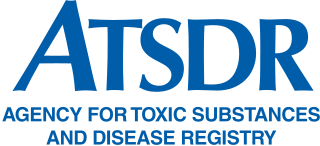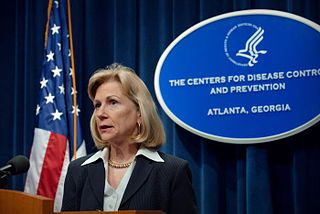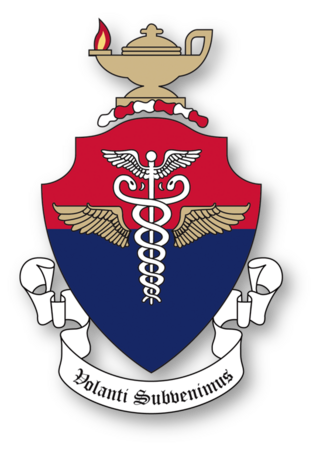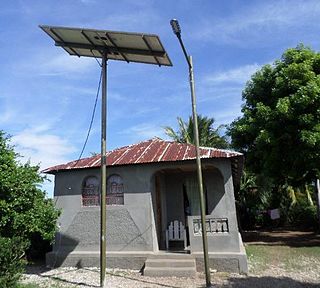
The Centers for Disease Control and Prevention (CDC) is the national public health agency of the United States. It is a United States federal agency under the Department of Health and Human Services, and is headquartered in Atlanta, Georgia.

The Agency for Toxic Substances and Disease Registry (ATSDR) is a federal public health agency within the United States Department of Health and Human Services. The agency focuses on minimizing human health risks associated with exposure to hazardous substances. It works closely with other federal, state, and local agencies; tribal governments; local communities; and healthcare providers. Its mission is to "Serve the public through responsive public health actions to promote healthy and safe environments and prevent harmful exposures." ATSDR was created as an advisory, nonregulatory agency by the Superfund legislation and was formally organized in 1985.

Health informatics is the study and implementation of computer structures and algorithms to improve communication, understanding, and management of medical information. It can be viewed as branch of engineering and applied science.
The Council of State and Territorial Epidemiologists (CSTE) is a 501(c)(6) non-profit organization originally organized in 1955, founded in 1992, and based in Atlanta, Georgia. CSTE works to advance public health policy and workforce capacity for applied public health epidemiologists in all localities, states, and territories in the United States.
The National Center for Health Statistics (NCHS) is a U.S. government agency that provides statistical information to guide actions and policies to improve the public health of the American people. It is a unit of the Centers for Disease Control and Prevention (CDC) and a principal agency of the U.S. Federal Statistical System. It is headquartered at University Town Center in Hyattsville, Maryland, just outside Washington, D.C.

The Biocomplexity Institute of Virginia Tech was a research institute specializing in bioinformatics, computational biology, and systems biology. The institute had more than 250 personnel, including over 50 tenured and research faculty. Research at the institute involved collaboration in diverse disciplines such as mathematics, computer science, biology, plant pathology, biochemistry, systems biology, statistics, economics, synthetic biology and medicine. The institute developed -omic and bioinformatic tools and databases that can be applied to the study of human, animal and plant diseases as well as the discovery of new vaccine, drug and diagnostic targets.

The Epidemic Intelligence Service (EIS) is a program of the U.S. Centers for Disease Control and Prevention (CDC). The modern EIS is a two-year, hands-on post-doctoral training program in epidemiology, with a focus on field work.
Public health surveillance is, according to the World Health Organization (WHO), "the continuous, systematic collection, analysis and interpretation of health-related data needed for the planning, implementation, and evaluation of public health practice." Public health surveillance may be used to track emerging health-related issues at an early stage and find active solutions in a timely manner. Surveillance systems are generally called upon to provide information regarding when and where health problems are occurring and who is affected.
Public health informatics has been defined as the systematic application of information and computer science and technology to public health practice, research, and learning. It is one of the subdomains of health informatics.
The National Center for Immunization and Respiratory Diseases (NCIRD), formerly known as the National Immunization Program until April 2006, is charged with responsibility for the planning, coordination, and conduct of immunization activities in the United States. NCIRD is a part of the Centers for Disease Control and Prevention, located in Atlanta, Georgia, and housed in the CDC's Coordinating Center for Infectious Diseases (CCID). The National Center for Immunization provides consultation, training, statistical, promotional, educational, epidemiological, and technical services to assist state and local health departments across the US in planning, developing, contracting and implementing immunization programs.
The Health Protection Agency (HPA) was a non-departmental public body in the United Kingdom. It was set up by the UK government in 2003 to protect the public from threats to their health from infectious diseases and environmental hazards.
The Public Health Information Network (PHIN) is a US national initiative, developed by the Centers for Disease Control and Prevention (CDC), for advancing fully capable and interoperable information systems in public health organizations. The initiative involves establishing and implementing a framework for public health information systems.

Nancy J. Cox is an American virologist who has served as the director of the Influenza Division at the Centers for Disease Control and Prevention (CDC) from 2006 to 2014 and as director of the CDC's World Health Organization (WHO) Collaborating Center for Surveillance, Epidemiology and Control of Influenza from 1992 to 2014. Cox served as the Chair and Co-Chair of the Scientific Advisory Council of GISAID, between the years 2008 and 2017 and is frequently recognized for having played an instrumental role in the success of GISAID.

Field Epidemiology is the application of epidemiologic methods to unexpected health problems when a rapid on-site investigation is necessary for timely intervention. A more expansive definition is: The practice of Epidemiology in the field. Work is done in communities often as a public health service and as part of government or a closely allied institution. Field epidemiology is how epidemics and outbreaks are investigated, and is used to implement measures to protect and improve the health of the public. Field epidemiologists must deal with unexpected, sometimes urgent problems that demand immediate solution. Its methods are designed to answer specific epidemiologic questions in order to plan, implement, and/or evaluate public health interventions. These studies consider the needs of those who will use the results. The task of a field epidemiologist is not complete until the results of a study have been clearly communicated in a timely manner to those who need to know, and an intervention made to improve the health of the people.
Workplace health surveillance or occupational health surveillance (U.S.) is the ongoing systematic collection, analysis, and dissemination of exposure and health data on groups of workers. The Joint ILO/WHO Committee on Occupational Health at its 12th Session in 1995 defined an occupational health surveillance system as "a system which includes a functional capacity for data collection, analysis and dissemination linked to occupational health programmes".
In analytical chemistry, biomonitoring is the measurement of the body burden of toxic chemical compounds, elements, or their metabolites, in biological substances. Often, these measurements are done in blood and urine. Biomonitoring is performed in both environmental health, and in occupational safety and health as a means of exposure assessment and workplace health surveillance.

The United States Air Force School of Aerospace Medicine (USAFSAM) is the United States Air Force (USAF) organization focused on education, research, and operational consultation in aerospace and operational medicine. USAFSAM was founded in 1918 to conduct research into the medical and physiologic domains related to human flight, and as a school for medical officers trained to support military aviation operations, later coined as flight surgeons. The school supported early military aviation from World War I through the evolution of aviation and into the modern era. USAFSAM conducted medical research and provided medical support for the initial US space operations beginning in 1947 through the establishment of NASA in 1958. After the creation of NASA, USAFSAM continued to actively support civilian and military manned space missions through clinical and physiologic research. USAFSAM is one of the oldest continually operating school for flight surgeons and other operational medical personnel of its kind in the world. USAFSAM is located in Dayton, Ohio at Wright-Patterson Air Force Base, and is part of the 711th Human Performance Wing and the Air Force Research Laboratory (AFRL).

Joseph Walter Mountin MD was an American physician and career United States Public Health Service (USPHS) officer who was the founder of the U.S. Centers for Disease Control and Prevention in Atlanta, Georgia. Mountin eventually became an assistant surgeon general. He was involved in many advancements in medical and sanitary science during his lifetime. He was an early advocate for a national health care system and wrote frequently on the need to provide broader health care coverage. He was considered influential in the development of public health improvements.

Rabies is a viral disease that exists in Haiti and throughout the world. It often causes fatal inflammation of the brain in humans and other mammals, such as dogs and mongooses in Haiti. The term "rabies" is derived from a Latin word that means "to rage"; rabid animals sometimes appear to be angry. Early symptoms can include fever and tingling at the site of exposure, followed by one or more of the following symptoms: violent movements, uncontrolled excitement, fear of water, an inability to move parts of the body, confusion, and loss of consciousness. Once symptoms appear, death is nearly always the outcome. The time period between contracting the disease and showing symptoms is usually one to three months; however, this time period can vary from less than a week to more than a year. The time between contraction and the onset of symptoms is dependent on the distance the virus must travel to reach the central nervous system.

Asian Institute of Public Health University is a Privately operated Public health university located in Bhubaneswar, Odisha, India. It was established in 2008 to bring the much needed expertise in various domains of public health to Odisha, emerging from close to two decades of community, hospital, and laboratory-based research and training in public health & expanding its contribution to a larger audience in the rest of country and in the neighboring Asian countries sharing population health problems of similar nature and magnitude. It was later conferred with university status after the AIPH University, Odisha Bill, 2017 was passed by the Odisha Legislative Assembly. It is the first Public health institute of India & the only entity in the country conducting public health education, research and service with expertise in all major domains of public health as well as the only institution that imparts required education at Masters and PhD level in the major domains of public health and conducts population-based hospital and laboratory research. The university has collaborated with well known Indian & global healthcare associations like AIIMS New Delhi, ICMR, WHO, UNICEF, London School of Hygiene & Tropical Medicine etc.










